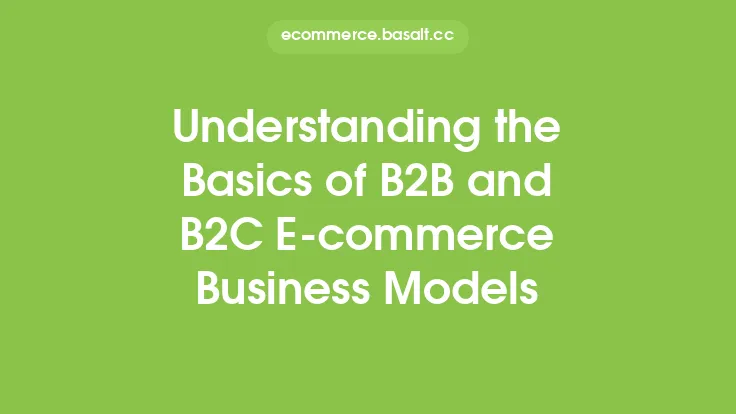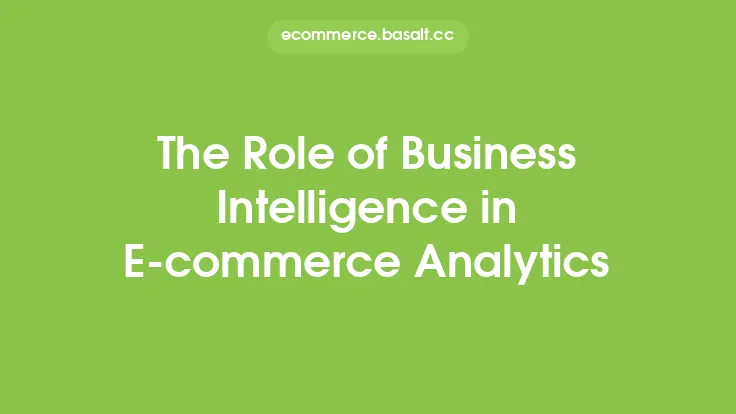In the world of e-commerce, understanding the basics of business models is crucial for success. An e-commerce business model refers to the framework that a company uses to generate revenue, manage operations, and deliver value to customers. It encompasses various aspects, including the type of products or services offered, the target market, marketing and sales strategies, and revenue streams. A well-defined business model is essential for e-commerce companies to differentiate themselves from competitors, attract and retain customers, and ultimately drive growth and profitability.
Key Components of E-commerce Business Models
E-commerce business models typically consist of several key components, including the value proposition, revenue streams, cost structure, and customer relationships. The value proposition refers to the unique benefits that a company offers to its customers, such as convenience, low prices, or high-quality products. Revenue streams, on the other hand, refer to the ways in which a company generates income, such as through sales, subscriptions, or advertising. The cost structure includes the expenses associated with running the business, such as production costs, marketing expenses, and shipping fees. Finally, customer relationships refer to the ways in which a company interacts with its customers, including through social media, email marketing, and customer support.
Types of E-commerce Business Models
There are several types of e-commerce business models, each with its own strengths and weaknesses. One common type is the business-to-consumer (B2C) model, in which companies sell products or services directly to individual customers. Another type is the business-to-business (B2B) model, in which companies sell products or services to other businesses. There are also hybrid models, which combine elements of B2C and B2B models, as well as niche models, which cater to specific industries or markets. Additionally, some e-commerce companies use a platform-based model, which involves creating a platform that connects buyers and sellers, such as online marketplaces or social media platforms.
Importance of Market Research and Analysis
Market research and analysis are critical components of e-commerce business models. Companies must conduct thorough research to understand their target market, including demographics, preferences, and behaviors. This information can be used to develop effective marketing and sales strategies, as well as to identify opportunities for growth and expansion. Market analysis can also help companies to identify potential competitors and to develop strategies for differentiating themselves in a crowded market. Furthermore, market research and analysis can help companies to stay up-to-date with the latest trends and technologies, ensuring that they remain competitive and relevant in a rapidly changing market.
Role of Technology in E-commerce Business Models
Technology plays a vital role in e-commerce business models, enabling companies to reach a wider audience, streamline operations, and improve customer experiences. E-commerce platforms, such as Shopify and Magento, provide companies with the tools and infrastructure they need to create and manage online stores. Payment gateways, such as PayPal and Stripe, enable secure and convenient transactions. Social media platforms, such as Facebook and Instagram, provide companies with opportunities for marketing and customer engagement. Additionally, technologies like artificial intelligence and machine learning can help companies to personalize customer experiences, optimize marketing campaigns, and improve operational efficiency.
Challenges and Opportunities in E-commerce Business Models
E-commerce business models are not without their challenges and opportunities. One major challenge is the intense competition in the e-commerce market, which can make it difficult for companies to stand out and attract customers. Another challenge is the need for continuous innovation and adaptation, as technologies and consumer behaviors are constantly evolving. However, these challenges also present opportunities for companies to differentiate themselves and to develop innovative solutions that meet the changing needs of customers. Additionally, the rise of e-commerce has created new opportunities for entrepreneurs and small businesses to reach a global audience and to compete with larger companies.
Best Practices for Developing a Successful E-commerce Business Model
To develop a successful e-commerce business model, companies should follow several best practices. First, they should conduct thorough market research and analysis to understand their target market and to identify opportunities for growth and expansion. Second, they should develop a unique value proposition that differentiates them from competitors and meets the needs of their target market. Third, they should invest in technology and infrastructure that enables them to streamline operations, improve customer experiences, and stay competitive. Fourth, they should focus on building strong customer relationships through effective marketing and customer support. Finally, they should continuously monitor and evaluate their business model, making adjustments as needed to stay ahead of the competition and to meet the changing needs of customers.
Conclusion
In conclusion, understanding the basics of e-commerce business models is essential for success in the world of e-commerce. By understanding the key components of business models, including the value proposition, revenue streams, cost structure, and customer relationships, companies can develop effective strategies for generating revenue, managing operations, and delivering value to customers. By conducting thorough market research and analysis, investing in technology and infrastructure, and focusing on building strong customer relationships, companies can develop successful e-commerce business models that drive growth and profitability. As the e-commerce market continues to evolve, it is essential for companies to stay up-to-date with the latest trends and technologies, and to continuously adapt and innovate to meet the changing needs of customers.





